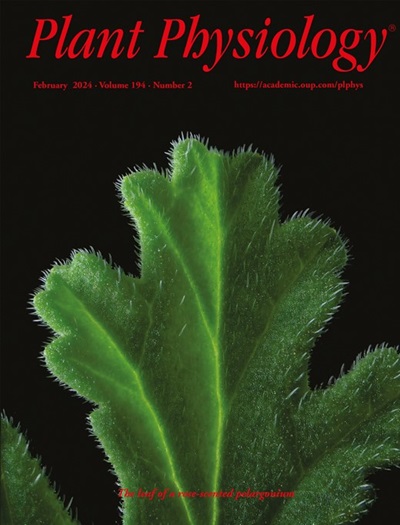Functionally differentiated GL2-interacting-repressor 1 homoeologs regulate epidermal hair development in Gossypium hirsutum.
IF 6.5
1区 生物学
Q1 PLANT SCIENCES
引用次数: 0
Abstract
Cotton (Gossypium. spp) stem trichomes and seed fibers are unicellular epidermal hairs regulated by relevant molecular networks. Genetic analysis of the glabrous stem landrace (Palmeri37) of Gossypium hirsutum L. has pinpointed GL2-interacting-repressor 1 (GhGIR1D), featuring a RING-like zinc finger domain, as the candidate gene underlying the stem glabrous trait. Overexpressing and silencing experiments confirm GhGIR1D as a negative regulator specifically for stem trichome initiation, without influencing leaf trichome or seed fiber. High endogenous expression of GhGIR1D is associated with a SNP-573 T/G variation within the promoter region, and GhGIR1D Hap I confers the absence of stem trichomes. The homoeologous protein, GhGIR1A, inhibits trichome and fuzz fiber initiation by disrupting the GhHD1D-GhHOX3A module (a complex of two Homeodomain-Leucine Zipper IV transcription factors, HD-ZIP IV), and repressing downstream transcription of GhRDL1. Trichome density was enhanced in GhHD1A overexpression transgenic lines but reduced in ghhd1a mutants, demonstrating the positive regulatory role of GhHD1A on stem trichome initiation. GhHD1 displays distinct effects on stem trichome and fuzz fiber initiation due to its tissue-specific dosage. In the ghhd1a mutants, repression of GhGIR1D restores the wild-type pubescent phenotype, suggesting the presence of a potential negative feedback loop between GhGIR1D and GhHD1A, or that GhGIR1D and GhHD1A may function within the same regulatory pathway with opposite functions in regulation of trichome development. These findings enhance our comprehension of the GhGIR1-GhHD1-GhHOX3 interaction module in epidermal hair initiation and development.功能分化的gl2相互作用抑制因子1同源物调控毛棉表皮毛的发育。
棉(Gossypium。茎毛和种子纤维是受相关分子网络调控的单细胞表皮毛。通过对毛棉(Gossypium hirsutum L.)无毛茎地方品种(Palmeri37)的遗传分析,确定了gl2相互作用抑制因子1 (GhGIR1D)为无毛性状的候选基因,该基因具有环状锌指结构域。过表达和沉默实验证实GhGIR1D是茎毛状体形成的负调控因子,不影响叶片毛状体或种子纤维。GhGIR1D的高内源性表达与启动子区域内SNP-573 T/G变异有关,GhGIR1D Hap I导致茎毛缺失。同源蛋白GhGIR1A通过破坏GhHD1D-GhHOX3A模块(两个Homeodomain-Leucine Zipper IV转录因子的复合体,HD-ZIP IV)和抑制GhRDL1的下游转录来抑制毛状体和绒毛纤维的起始。GhHD1A过表达转基因品系的毛状体密度增强,而GhHD1A突变品系的毛状体密度降低,表明GhHD1A对茎毛状体起始有正向调节作用。GhHD1因其组织特异性剂量对茎毛状体和绒毛纤维的形成有明显的影响。在ghhd1a突变体中,GhGIR1D的抑制恢复了野生型短毛表型,这表明GhGIR1D和ghhd1a之间存在潜在的负反馈回路,或者GhGIR1D和ghhd1a可能在相同的调节途径中发挥作用,但在调节毛状体发育方面具有相反的功能。这些发现增强了我们对表皮毛发发生和发育中GhGIR1-GhHD1-GhHOX3相互作用模块的理解。
本文章由计算机程序翻译,如有差异,请以英文原文为准。
求助全文
约1分钟内获得全文
求助全文
来源期刊

Plant Physiology
生物-植物科学
CiteScore
12.20
自引率
5.40%
发文量
535
审稿时长
2.3 months
期刊介绍:
Plant Physiology® is a distinguished and highly respected journal with a rich history dating back to its establishment in 1926. It stands as a leading international publication in the field of plant biology, covering a comprehensive range of topics from the molecular and structural aspects of plant life to systems biology and ecophysiology. Recognized as the most highly cited journal in plant sciences, Plant Physiology® is a testament to its commitment to excellence and the dissemination of groundbreaking research.
As the official publication of the American Society of Plant Biologists, Plant Physiology® upholds rigorous peer-review standards, ensuring that the scientific community receives the highest quality research. The journal releases 12 issues annually, providing a steady stream of new findings and insights to its readership.
 求助内容:
求助内容: 应助结果提醒方式:
应助结果提醒方式:


